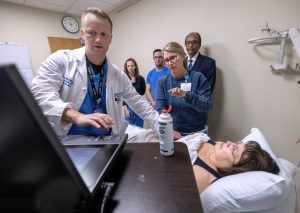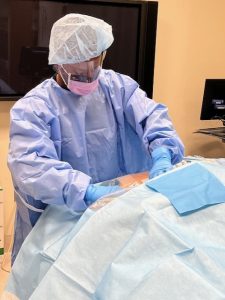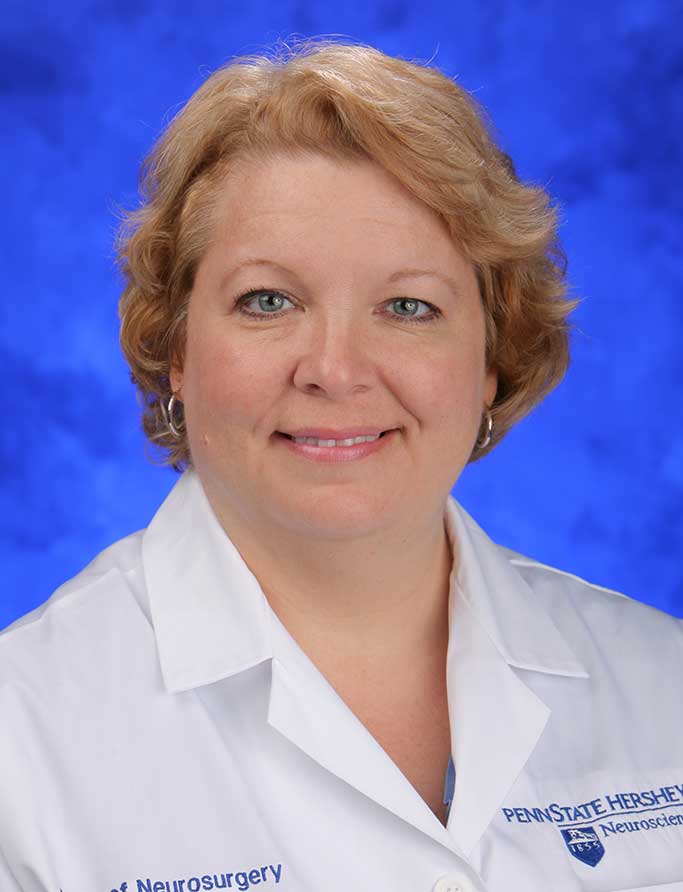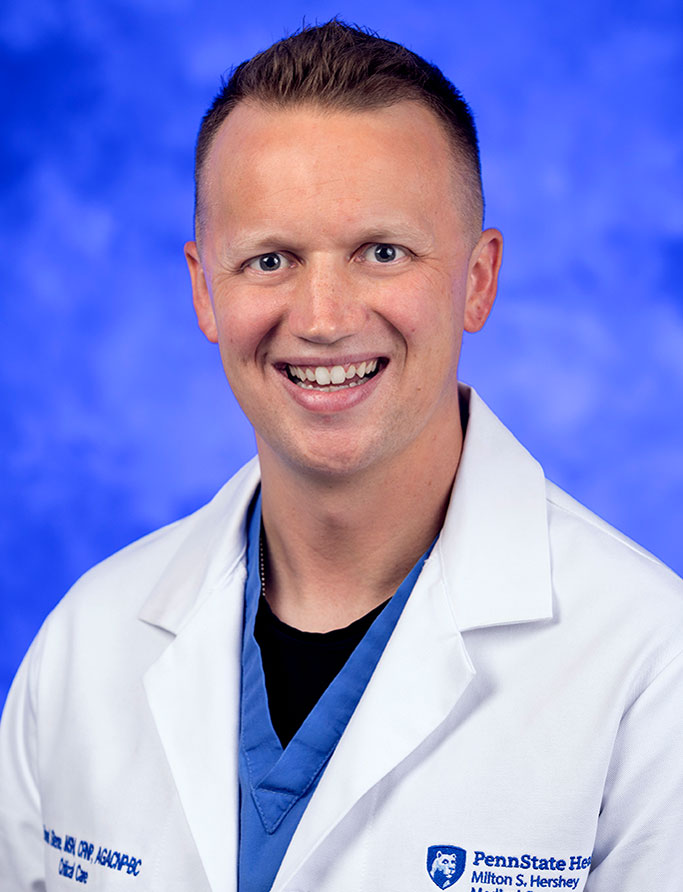Jump to topic
Search
Program Details
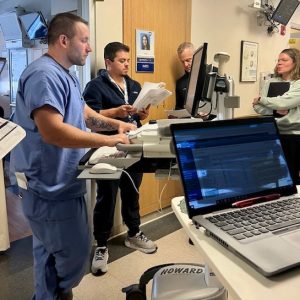
Luca Calero PA-C, current APP fellow, presents his patient to Dr. Chris Zacko during ICU rounds. Lenny Shamus, AGACNP, fellowship faculty, provides oversight.
Penn State Health’s Advanced Practice Provider Critical Care Fellowship is a post–graduate, transition-to-practice training program for physician assistants and acute care nurse practitioners who have a sincere interest in a career as a critical care APP.
The 12-month program includes clinical rotations through Penn State Health’s adult critical-care units. In addition, trainees will have clinical experiences with services that are integral in supporting critical care including nephrology, palliative care and infectious disease. Trainees are expected to work a minimum of 36 hours per week clinically.
In addition to the variety of clinical experiences, there are didactic sessions as well as hands-on in the high-fidelity Clinical Simulation Center. Learning will also be enhanced using online learning modules, case conferences, evidenced-based readings and journal clubs. The trainee can expect to dedicate approximately 10 to 12 hours a week completing these learning activities.
Learn More about the Fellowship
“This experience has been nothing short of transformative, pushing my skills, knowledge and resilience to new heights. I’ve had the privilege of learning from some of the best in the field, and the camaraderie and support from my mentors and peers have been invaluable.”
General Applicant Information
The program is affiliated with Penn State Health Milton S. Hershey Medical Center, and fellows are hired as full-time employees with benefits, which includes a Continuing Medical Education allowance. Applicants must be graduates of an accredited acute care nurse practitioner or physician assistant program, and board-certified through one of the major accrediting bodies specific to their discipline.
To apply for the APP Critical Care Fellowship, applicants must provide the following items:
- A personal statement, to include the applicant’s purpose in fellowship study and future professional goals as they relate to Critical Care.
- An updated curriculum vitae, to include a detailed description of prior critical care experience, if applicable.
- Minimum of three letters of recommendation, at least one from current or recent supervising physician or advanced practice clinician (nurse practitioner or physician assistant).
- An application through the Human Resources website.
“I wholeheartedly endorse and recommend this fellowship to new advanced practice providers who aspire to become confident and skilled professionals.”
Virtual Tour
Penn State Health
Penn State Health is an integrated academic health system serving patients and communities across 15 counties in central Pennsylvania. It employs more than 20,900 people systemwide.
The system includes Penn State Health Milton S. Hershey Medical Center, Penn State Health Children’s Hospital and Penn State Cancer Institute based in Hershey, Pa.; Penn State Health Hampden Medical Center in Enola, Pa.; Penn State Health Holy Spirit Medical Center in Camp Hill, Pa.; Penn State Health Lancaster Medical Center in Lancaster, Pa.; Penn State Health St. Joseph Medical Center in Reading, Pa.; Pennsylvania Psychiatric Institute, a specialty provider of inpatient and outpatient behavioral health services, in Harrisburg, Pa.; and 2,417 physicians and direct care providers at 225 outpatient practices. Additionally, the system jointly operates various healthcare providers, including Penn State Health Rehabilitation Hospital, Hershey Outpatient Surgery Center and Hershey Endoscopy Center.
In 2017, Penn State Health partnered with Highmark Health to facilitate creation of a value-based, community care network in the region.
Penn State Health shares an integrated strategic plan and operations with Penn State College of Medicine, the University’s medical school. With campuses in State College and Hershey, Pa., the College of Medicine boasts a portfolio of more than $150 million in funded research and more than 1,700 students and trainees in medicine, nursing, other health professions and biomedical research.
Learn more about Penn State Health

Penn State Health Children’s Hospital (left), Penn State Health Milton S. Hershey Medical Center (center) and Penn State Cancer Institute (right)
Penn State Health Milton S. Hershey Medical Center
500 University Dr., Hershey, Pa., 17033 (Derry Township, Dauphin County)
- The health system’s 611-bed flagship teaching and research hospital
- The only medical facility in Pennsylvania accredited as both an adult and a pediatric Level I (highest-level) trauma center
- Dedicated surgical, neuroscience, cardiovascular, trauma and medical intensive care units
- Accredited Life Lion critical-care transport providing more than 1,100 helicopter and approximately 750 ground ambulance transports per year
- More than 1,300 faculty members and more than 650 residents and fellows
- Approximately 29,000 admissions, 73,000 emergency department visits, 1.1 million outpatient visits and 33,000 surgical procedures annually
- Designated as a Magnet hospital since 2007
Learn more about Milton S. Hershey Medical Center
Penn State Health Children’s Hospital
600 University Dr., Hershey, Pa. 17033 (Derry Township, Dauphin County)
- An eight-story, 263,000-square-foot-facility built in 2013 and expanded in 2020
- 160 licensed pediatric beds, 26-bed pediatric intensive care unit and a 56-bed neonatal intensive care unit
- Level IV (highest-level) neonatal intensive care unit
- Level I quaternary (highest-level) pediatric intensive care unit
- Level I (highest-level) pediatric trauma center designation
- Intermediate care unit
- Dedicated pediatric operating rooms
- More than 150,000 pediatric outpatient visits, 20,000 pediatric emergency room visits, and approximately 5,000 pediatric patient discharges annually
Welcome to Hershey
More About Hershey
Interested in learning more about living and working in Hershey, Pa.? See details here:
Fellow wellness, including emotional, spiritual, social and physical health, is a crucial component to training and to becoming a professional, compassionate and resilient physician. Self-care is a skill which must be continually practiced and reinforced. Penn State College of Medicine and Penn State Health are committed to addressing wellness, with multiple resources readily available.
Institutional resources
Institutional Resources
Penn State Health and Penn State College of Medicine celebrate, embrace and support the diversity of all patients, faculty, staff, students and trainees.
Office for Diversity, Equity and Inclusion
In keeping with this, Penn State Health has an active Office for Diversity, Equity and Inclusion with various programs, networks and resource groups, including:
- Talks and lectures on diversity, equity and inclusion through the Inclusion Academy
- Regular events on topics such as eradicating racism and creating a culture of inclusiveness
- Many Business Employee Resource Groups (BERGs), including:
- Disability Business Employee Resource Group
- Interfaith Business Employee Resource Group
- LGBTQ+ Business Employee Resource Group
- Military and Veterans Business Employee Resource Group
- Multicultural Business Employee Resource Group
- NextGen Business Employee Resource Group
- Black Physician Professional Staff Association – Resource Group
- Hispanic Professional Association
- Asian Physician and Professional Staff Association
- International Workforce Inclusion
- Inclusion Academy
Learn more about the Penn State Health Office for Diversity, Equity and Inclusion
Learn more about the College of Medicine’s Office for Diversity, Equity and Belonging
Office for Culturally Responsive Health Care Education
The vision at Penn State College of Medicine and Penn State Health is to equip learners with the knowledge, skills and attitudes they will need to provide culturally excellent health care and research for an increasingly diverse U.S. population. The Office for Culturally Responsive Health Care Education was formed to help meet that goal.
Learn more about the Office for Culturally Responsive Health Care Education
Office for a Respectful Learning Environment
In addition, the institution does not tolerate discrimination, biases, microaggression, harassment or learner mistreatment of any kind, and any concerns are immediately addressed by the Office for a Respectful Learning Environment.
Learn more about the Office for a Respectful Learning Environment
Network of Under-represented Residents and Fellows
The Network of Under-represented Residents and Fellows (NURF) is a group of diverse residents and fellows representing all specialties. NURF’s goal is to promote cultural diversity in the residency programs through community involvement, mentorship with diverse faculty, professional networking and support for the recruitment of diverse medical students into the residency programs.
NURF is sponsored by the Penn State College of Medicine Graduate Medical Education Office and the Penn State Health Office for Diversity, Equity and Inclusion.
Curriculum Details
The fellowship’s mission is to provide a structured, comprehensive, transition-to-practice program to enhance the knowledge and skills of APPs who will serve the health needs of critically ill adults.
“Through my participation in the fellowship, I was able to gain the skills to succeed in my career through hands on learning. I constantly use and appreciate the knowledge gained from the fellowship.”
- Expand the knowledge and skills of novice APPs in order to provide safe, high-quality, cost-effective and evidence-based care to critically ill adults.
- Cultivate the APP leaders of the future, who will inspire innovation and share knowledge that will benefit all.
- Increase the confidence of APP trainees in performing procedures and therapeutic interventions.
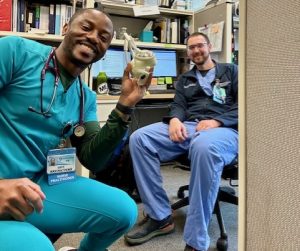
Marvil Dunbar, AGACNP, left, and Tyler Thomas, AGACNP, fellowship faculty, during the Heart and Vascular ICU rotation.
- Neuroscience intensive care
- Heart and vascular intensive care
- Medical intensive care
- Nephrology
- Infectious disease
- Palliative care
- Elective (six weeks)
- Trauma services
- Surgical Critical Care
- Advanced Airway
Note: These clinical rotations are subject to change.



